|
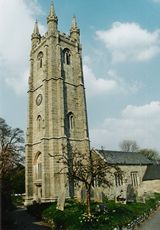
Exterior view of St Pancras, with its soaring
granite tower
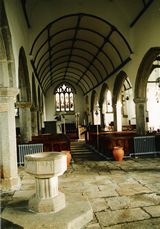
Interior view of the nave,
looking East
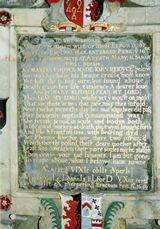
The inscrbed tablet to Mary,
wife of John Elford,
who died in February 1643
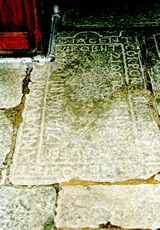
The tombstone of Roger Hill,
who died 21 October 1638,
and his wife Ann, who died
ten years later.
|
Cromwellian Britain
- Widecombe-in-the-Moor, Devon
Dartmoor, like most of the upland reaches of Britain,
was not actively fought over during the civil war. A high moor, thinly
populated, with no significant urban centres and, despite its mineral
deposits, in the seventeenth century not particularly affluent, it
possessed neither the resources nor the easy lines of communication to
make it attractive to rival armies. Devon as a whole was hotly contested
and changed hands twice. Initially held for parliament, it fell to the
king in 1643 and remained in royalist hands until 1645-6, when it was
recaptured by Fairfax, Cromwell and the New Model Army. There was
significant action along the roads and in and around the townships which
fringed the moor. In the opening months of the war, the two sides
clashed around Dunsford and, in February 1643, at Chagford, resulting in
a street fight in which the royalist poet Sidney Godolphin was badly
wounded and reputedly bled to death in the porch of the Three Crowns; in
April 1643 local parliamentarians ambushed a party of Cornish royalists
on Sourton Down and a running fight developed; and in January 1646, as
part of the parliamentary reconquest of the county, Cromwell himself
attacked and scattered royalists camped outside Bovey Tracey.
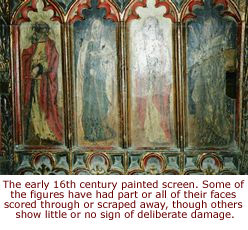 Although the heartlands of Dartmoor largely escaped direct fighting,
they certainly contributed men who fought and in many cases were killed
elsewhere. Mark Stoyle has recently portrayed early Stuart Dartmoor,
along with much of mid Devon, as a somewhat isolated region of the
county, far removed from the new ideas and new influences found in the
ports and the main urban centres. There was a relatively static
population – Stoyle found that of the 107 family names recorded in the
moorland parish of Widecombe between 1600 and 1634, 51% were still there
in the period 1700-34, a much higher figure than found in other parts of
Devon and elsewhere in England – which was conservative in religion,
resisting reformist ideas, and which retained the old customs of church
ales and popular festivals. In the light of this it is not surprising to
discover that this was an area of popular royalism, in clear contrast to
the north, south and parts of the east of the county, which showed
evidence of popular parliamentarianism. Records of those killed and
maimed in the king's service suggest that many of the parishes of mid
Devon in general and Dartmoor in particular contributed a much higher
proportion of adult males to the royalist armies than parishes elsewhere
in the county.[1] Although the heartlands of Dartmoor largely escaped direct fighting,
they certainly contributed men who fought and in many cases were killed
elsewhere. Mark Stoyle has recently portrayed early Stuart Dartmoor,
along with much of mid Devon, as a somewhat isolated region of the
county, far removed from the new ideas and new influences found in the
ports and the main urban centres. There was a relatively static
population – Stoyle found that of the 107 family names recorded in the
moorland parish of Widecombe between 1600 and 1634, 51% were still there
in the period 1700-34, a much higher figure than found in other parts of
Devon and elsewhere in England – which was conservative in religion,
resisting reformist ideas, and which retained the old customs of church
ales and popular festivals. In the light of this it is not surprising to
discover that this was an area of popular royalism, in clear contrast to
the north, south and parts of the east of the county, which showed
evidence of popular parliamentarianism. Records of those killed and
maimed in the king's service suggest that many of the parishes of mid
Devon in general and Dartmoor in particular contributed a much higher
proportion of adult males to the royalist armies than parishes elsewhere
in the county.[1]
Widecombe-in-the-Moor was and is a large parish in the eastern half of
Dartmoor. Although the village itself lies in a slight valley, the land
rises steeply above the settlement, and in the seventeenth century, as
now, it was an area of scattered farms, with rough grazing for sheep and
cattle, and tiny hamlets. At the time of the civil war the adult male
population of the entire parish probably totalled less than 150.
Nevertheless, there is evidence of some wealth in the area, most obvious
in the surprisingly large and elegant parish church of St Pancras with
its soaring, late medieval tower, probably built out of the profits of
medieval tin-working in the locality. Now rather too popular for its own
good during the summer months, Widecombe has become well known for its
fair and associated song, and for the large numbers of tourists and
coaches which converge upon it. But at heart, and particularly out of
season, it remains a very attractive village, especially the small
square on rising ground, framed by the church and churchyard, the Glebe
House of 1527 and the Old Church House, dating from the sixteenth or
early seventeenth century, which has served at different times as
alehouse, poorhouse, schoolhouse and almshouses.
Although there is no record of fighting here during the civil war,
Widecombe acquired considerable fame or notoriety in the mid seventeenth
century because of the terrible storm which hit the village in autumn
1638. News of the events quickly spread through England and within a
week or so of the storm, a pamphlet describing ‘those most strange and
lamentable accidents’ was published in London. It quickly sold out and a
second, larger account was produced.[2] Together, they provide a graphic
and at times gory description of the events which occurred in Widecombe
on Sunday 21 October 1638, during divine service, as allegedly recounted
by eye-witnesses who had ‘now come to London’. The authors justified the
pamphlets by pointing to the lessons which all might learn from God’s
dramatic intervention in the world:
‘GODS visible judgements, and terrible remonstances...comming unto our
knowledge, should be our observation and admonition, that thereby the
inhabitants of the earth may learn Righteousnesse, for to let them pass
by us...unobserved, argues too much regardlessnesse of GOD in the way of
his Judgements...But to heare and feare and to doe wickedly no more, to
search our hearts and amend our waies is the best use that can bee made
of any of GODS remarkable terrors manifested among us. When GOD is angry
with us, it ought to be our wisdome to meete him, and make peace with
him...Except wee repent, wee shall likewise perish...Therefore this
should awe and humble our hearts before the LORD, rising up into more
perfection in godlinesse, doing unto our GOD, more and better service
then ever hitherto wee have done, reverencing and sanctifying his
dreadfull Name in our hearts, especially when his Judgements breake in
upon men, even in his owne house, mingling their bloud with their
sacrifices, and in that most terrible manner smiting, and wounding, and
killing, as in this ensuing Relation may appeare...The Lord teach thee
to profit thereby, that it may bee as a Sermon to thee from Heaven by
the Lord himselfe.’
The two accounts which followed described how the sky darkened strangely
during the Sunday service, so that the congregation could not read their
books and could barely see one another, closely followed by ‘a mighty
thundering’ and ‘terrible strange lightening’. The lightening struck the
church tower, badly damaging it and causing one of the corner pinnacles
to collapse through the roof of the nave. Either that bolt or a second
strike entered the nave itself in the form of ball lightening, and some
of the congregation recalled seeing ‘a great fiery ball come in at the
window and passe through the Church’, accompanied by fire, smoke and a
strong smell of brimstone. Most of the congregation threw themselves to
the floor amidst great cries ‘of burning and scalding’. The minister,
George Lyde, was in the pulpit when the lightening struck, but even
though it passed close by, leaving one of the faces of the pulpit ‘black
and moist as if it had beene newly wiped with Inke’, he was unhurt.
However, ‘the lightening seized upon his poor Wife, fired her ruffe and
linnen next to her body, and her cloathes, to the burning of many parts
of her body in a very pitifull manner’. A friend sitting next to her was
also ‘much scalded’ and another unnamed woman ran out of the church with
her clothes on fire and was left not only ‘strangely burnt and scorched,
but had her flesh torne about her back almost to the very bones’. Two
male members of the congregation were killed, Roger Hill and Robert
Meade, warrener to Sir Richard Reynell, both apparently by being thrown
back so violently by the lightening that their heads were smashed
against the church wall. The accounts describe in detail how the
unfortunate warrener has his skull smashed open so that his brains were
thrown out and a bloody indentation made in the wall. Many others were
injured, some of whom subsequently died: a woman who ‘had her flesh so
torne and her body so grievously burnt’ died the following night and a
man sitting close to the warrener was burnt all over and lingered ‘in
great misery’ about a week. On the other hand, there were remarkable
escapes, of people whose hats or clothes were burnt off but their bodies
left untouched, of small children forgotten and abandoned in the ensuing
chaos who wandered out of the ruins unharmed some hours later: ‘but it
pleased GOD yet in the midst of judgement to remember mercy, sparing
some and not destroying all’.
The church itself was badly damaged by the lightening. The ball
lightening within the body of the church burnt or overturned pews,
scorched the stonework and caused one of the main beams to collapse,
though it fell harmlessly to the floor between the minister and the
clerk. The tower was also badly damaged and its partial collapse in turn
damaged the roof of the nave. The following day two volunteers ventured
up the wrecked tower, despite the ‘loathsome smell beyond expression, as
it were of Brimstone pitch and sulphur’, to inspect the damage. One
turned back in fear and the other was violently sick that night. On the
Monday, too, the minister conducted a joint service for the first two
victims, Hill and Meade, who were buried side by side at the east end of
the nave; when Lyde threw some earth onto the coffins, the sudden noise
caused those attending the funeral to ‘runne out of the Church, tumbling
over one another supposing that the Church was falling on their heads’.
The lightening strike at Widecombe church was referred to nearly twenty
years later, in a pamphlet addressed to the Protector and the second
Protectorate Parliament, attacking ‘the Idolatrous High-places which are
still kept up, under pretence of usefulness and convenience of Worship’.
The pamphlet, which George Thomason dated 10 December 1656,[3] comprises
an outspoken attack upon church towers and steeples and the bells housed
within them, as ‘useless...unprofitable...idolatrous’, ‘to be utterly
destroyed’. ‘Are they [steeples] not the Pope’s pillars? for they were
erected by the Catholic Papists, in honour of their Popish gods...Down
with them and their Babylonish Bells, to the very ground, and let not a
stone of them remain upon another’. The anonymous author, possibly
Samuel Chidley, notes with approval that the year before God had caused
a thunderbolt to strike ‘Sin Botolphs Steeple at Boston’. Although the
events at Widecombe are not discussed in the main text, the pamphlet
opens with a verse –
‘Protectors, Parliaments, and all, see, hear,
And quake for fear: O do not jeer, nor swear
‘Gainst God, who roars from Sion on your sin,
‘Gainst such High-places which you worship in.
J[ehov]ah with his burning blasts of lightening quells
The Peoples Idols-Temples-Steeples-Bells’
– below which is reproduced a crude engraving of the lightening strike
on Widecombe church on 21 October 1638, with the note ‘A most prodigious
& fearefull storme of winds lightening & thunder, mightily defacing
Withcomb-church in Devon, burneing and slayeing diverse men and women
all this in service-time’. The engraving shows one bolt hitting the
church tower, causing a pinnacle to collapse, and another fiery ball
heading for the nave. The near wall of the nave has been removed so that
the illustrator can depict the chaos inside. There is fire and smoke in
the nave, members of the congregation are in disorder, a male figure
lies face down in the foreground and part of a pillar or beam is falling
close to the pulpit, in which the mmister stands.
Widecombe church, which is generally unlocked and open to visitors,
contains several echoes of the great storm. The village schoolmaster at
the time, Richard Hill, wrote a long poem about the storm, which was
painted on boards in the church. The present set of boards, now hanging
in the base of the tower, are replacements made in the 1780s. At the
east end of the nave, close to the chancel, can be seen the gravestone
of one of the victims, which bears a still legible Latin inscription
showing that it is the resting place of Roger Hill, gentleman, who died
on 21 October 1638, and of his widow Anne, who died ten years later. A
similar gravestone next to it, without an inscription, probably marks
the burial place of Robert Meade, the warrener. Two other features of
the splendid, principally Perpendicular church should be noted. Although
the upper part of the wooden screen and its rood loft have long gone,
the lower part, probably of the early sixteenth century, survives,
complete with paintings of various saints and martyrs. Several have had
their faces scored through or scraped away. Although such defacement is
invariably ascribed to civil war iconoclasm, there is here, as in so
many churches, no evidence to link it to the mid seventeenth century.
The iconoclasm of the opening stages of the sixteenth century English
Reformation, or post-early modern vandalism, might just as easily be to
blame. And on the north wall of the nave is an inscribed tablet to Mary,
third wife of John Elford of Sheepstor. Married in February 1641/2, she
died in February 1642/3, shortly after the birth of her twin daughters,
and was buried here. The elaborate tablet, erected in 1650, commemorates
her in verse. The inscription notes that her name, Mary Elford, is an
anagram of ‘Fear My Lord’, and includes within it various characters
which, read as Roman numerals, give her age at death (25) and the year
of her death and burial (1642 old style).
Notes.
-
Mark Stoyle, Loyalty and Locality. Popular Allegiance in
Devon during the English Civil War (Exeter, 1994).
-
A True Relation of those most strange and lamentable
Accidents, happening in the Parish Church of Wydecombe in Devonshire and
A Second and Most Exact Relation of those Sad and Lamentable Accidents
which happened in and about the Parish Church of Wydecombe neere the
Dartmoores. Both have been reprinted with a brief introduction and notes
by M Brown, The Great Storm at Widecombe, 21 October 1638 (Plymouth,
1996).
-
British Library, Thomason Tract, E 896 (9). The British
Library catalogue lists the pamphlet as a work of Chidley.
By Dr Peter Gaunt
|
